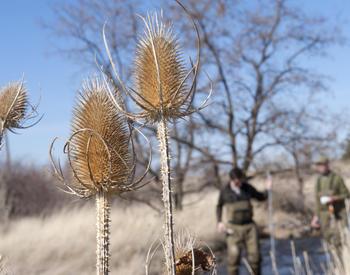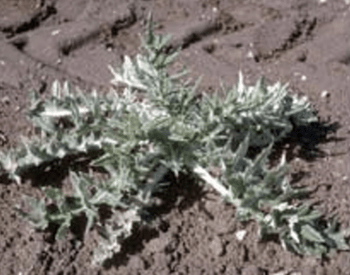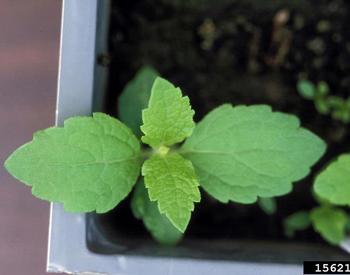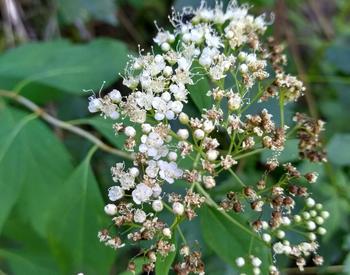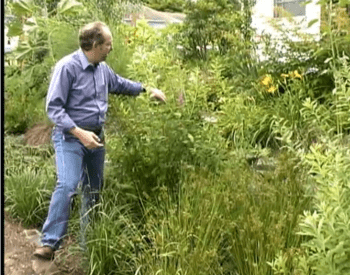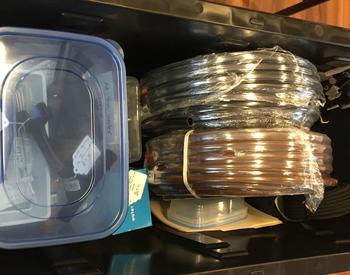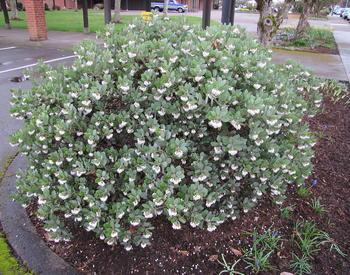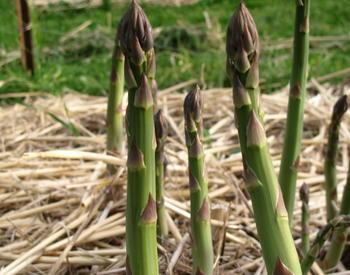English ivy (Hedera helix) is a European forest vine that has become invasive in the U.S. Because it is such an effective groundcover, it had been recommended for years as a landscape staple — at least until we began to recognize its full potential as an invasive species. Ivy League schools and ivy-covered brick buildings are icons of a gracious and privileged way of life. Ivy motifs decorate tablecloths, botanical texts and artwork.
In art, at least, ivy doesn’t produce seeds. But in nature, the spread through seeds is causing serious economic harm. So, it needs to be controlled. Mow it, discourage it, pull it, whack it down, remove its flowers and fruits, and most importantly, keep it from growing into its mature form.
Note: Some people are sensitive to English Ivy and develop a rash when they touch it or work with it. Use caution until you know how your skin reacts to it.
Life-saver English ivy removal from trees
The "Life Saver" method aims to remove ivy from the base and trunk of the tree to give it some “relief” while more complete ivy removal is in progress. The picture sequence gives some of the details. It took two people about two hours to complete this sequence for the one tree shown in the photos. “Life Saver” refers to making a circle 3–5 feet from the tree free of ivy, the Life Saver candy. The tree itself is the hole in the middle.
First, cut the ivy “trunks” or vines all the way around the tree at about eye level. Clippers work well for the smaller vines and for exposing the vines themselves. The vines attach to the bark with aerial roots. But with persistence, they can be peeled away. Some of the vines cut more easily with a hand-held pruner, at least once they get to be a half-inch or more in diameter. For the larger vines, a small hand saw does the work well. Again, persistence is in order since the growing vines seem to “fuse” with one another when they overlap, creating quite a strong bond as the vines get larger in diameter. For very large vines, people may get out their chain saw. But in those cases, the ivy has been growing a very long time indeed!
As you cut the vines, you can sometimes hear a very satisfying “snap” as the tension in the plant's vascular system is released. As you cut the vines, begin to peel them downward from the bark, one at a time (or several at a time if they are fused). Then, by folding them back, you can sometimes snip off the branches on the bottom of the peeled sections. Just toss the pieces you remove on the ground — cleanup can come later. Work your way down the trunk to the base of the tree and pull back the ivy from the tree at ground level at least 3 to 5 feet.
To clear the ground at least 3-5 feet from the base of the tree, you may need to do some serious pulling. Inevitably, vines will pull away from the roots, but you can try to come back later to get them when they re-sprout. As you remove vines, lay them “roots up” in the cartoon “dead mouse” pose, so the roots dry out and the vine dies. This is sometimes called “sheet composting” and seems to work in the short term, at least.
Now, sit back and watch as the ivy that remains on the tree dies. This can take several months in winter. By the time I am writing this at the end of July, the ivy is already dead in the upper reaches of my Douglas fir. As it starts to decay, it will shrivel, the leaves will fall off, and the entwined dead ivy branches will eventually fall off, probably during a winter storm. This may take several years. Meanwhile, it is doing little harm to the canopy of the tree and is not producing seeds.
Tackling the fence line
When ivy is ready to reproduce — usually when it has had a chance to reach sunlight — the leaves change from the juvenile form (the classic ivy leaf shape) to larger heart-shaped leaves. Look at the pictures for a comparison. When this happens, the English ivy produces flowers and seeds, which are eaten by birds. The birds often swallow them whole, and the seeds are deposited in the droppings. Very few birds, except starlings, use the seeds for food. Since the seeds are sticky, they also stick to birds' feet as they move around from tree to tree. They germinate easily and grow quickly, so even when you have completed ivy removal you can get new seedlings regularly; these are very easy to hand-pull when they are young.
It takes about two hours to clear 2 linear feet from a 7- to 8-foot-tall cedar fence. Once the ivy has been on the fence a long time, the fence underneath is in pretty bad shape and the entire fence could just topple over into the yard, ivy and all.
With clippers handy, start at one end, cutting the ivy vines into about 2-foot lengths and piling them up until the yard waste bin is available again for biweekly pickup. The composting system at the city yard waste depot will almost assuredly finish the process of killing the vines, especially since they have to sit in that pile for up to a month before the recycling part, and are mostly dead by the time they get into the yard waste bin. This is not recommended for all invasive species, since many can re-sprout from even the tiniest fragment. But for ivy, it is probably OK.
More information
Here are a few other links for more information if you are interested in your own ivy removal project.
